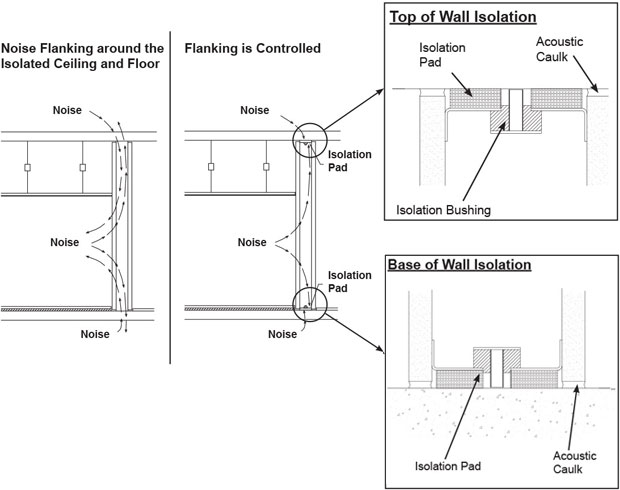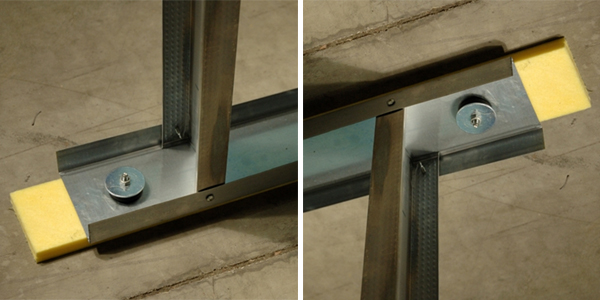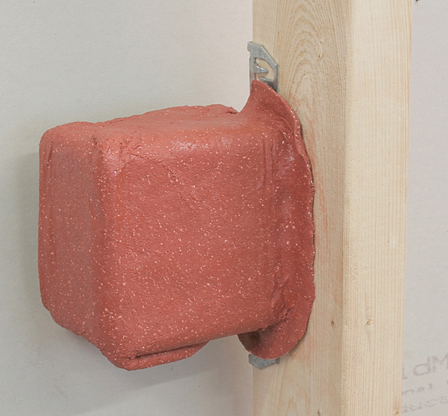Noise Control and Isolation for Multi-Family/Mixed Use Construction
Wall Isolation Pads Prevent Flanking Noise
Rarely mentioned or directly addressed, flanking noise is noise that reaches a room by an indirect path. An example would be sound reaching the room above or adjacent to a den where loud music is played from a route other than through the ceiling or wall. Resilient partition isolation pads prevent flanking noise by decoupling a sound-rated partition from a non-isolated structure. Flanking of sound through a floor/ceiling assembly can reduce STC or IIC ratings 10 points or more.

Isolation pads control flanking noise in ceiling, floor and walls.

Photos courtesy of Kinetics Noise Control
Examples of isolation pads on ceilings and floors.

Photo provided by Kinetics Noise Control
Outlet backer putty pads maintain acoustical ratings in fire rated walls.
Acoustical Outlet Backer Pad
Outlet backer putty pads maintain acoustical ratings in fire rated walls. Classified for metallic and non-metallic boxes to prevent the spread of smoke, fire and toxic gases, they are easy to apply and will not harden. An unsealed outlet can degrade STC 5 to 10 points.
LEED®—Acoustical Treatment Can Help Earn LEED Points
LEED BD+C: Multifamily Midrise | v4 - LEED v4
Acoustic comfort
Possible 1 point
Intent
Provide acoustic comfort by minimizing intruding noise into and within buildings.
Requirements
These requirements only apply to “acoustically sensitive” rooms, such as bedrooms, dining rooms, living rooms, and studies. (“Acoustically insensitive” rooms include bathrooms, kitchens, and hallways.) Projects may also implement the measures throughout the entire home.
Option 1. Prescriptive noise reduction methods.
Meet all of the following requirements:
1. Mechanical systems must meet the following requirements:
- Continuous ventilation fans shall have a maximum sound rating of 0.7 sones. Intermittent fans shall have a maximum sound rating of 1.5 sones, unless their maximum rated airflow exceeds 400 cfm. HVAC air handlers and remote-mounted fans are exempted, if the fans are mounted outside the habitable spaces, bathrooms, and hallways, and if there is at least 4 feet of ductwork between the fan and the intake grill.
- Meet the following best-practice HVAC installation measures:
- Ducts are securely attached (no loose connections between sections of ductwork).
- The fan housing is securely anchored.
- The damper flap closes fully, with no visible airspaces around the flap.
- For projects that are less than a half a mile away from any significant noise source such as (but not limited to) aircraft over-flights, highways, trains, and industry, exterior assemblies must include:
- Exterior windows and doors must have a minimum STC rating of 35.
- All exterior wall penetrations must be sealed with acoustical sealant, and/or otherwise treated for sound control (e.g. lined elbows on vents, lined exterior ducts where feasible).
- Attached single family homes and multi-family homes must also meet the following:
- Party walls must have a minimum STC rating of 55.
- All party wall penetrations must be sealed with acoustical sealant
- Floor/ceiling assemblies must have a minimum STC and IIC rating of 55.
AND/OR
Option 2. Performance-based compliance requirements
Meet all of the following. The tested levels must be met in the acoustically sensitive room that is considered the worst case condition.
1. The maximum background noise level in the home or unit due to exterior noise sources cannot exceed 40 dBA, based on the peak hour Leq.
2. The maximum background noise level in the home or unit due to interior noise sources (HVAC systems, lighting, and other building services operating simultaneously) shall not exceed 40 dBA, based on the peak Leq.
3. Party walls must have a minimum NIC rating of 50.
4. Floor-ceiling assemblies between units must have a minimum NIC and FIIC rating of 50.
Ductless systems qualify for this credit.
Conclusion
Intrusive noise for occupants of multi-family housing elevates stress, induces stress related health issues and creates the potential for litigation. Often ignored by both developers and design professionals, sound control must be addressed during the design phase since sound control remediation is extremely expensive and impractical to implement. Design professionals are urged to consult acoustical specialists in order to achieve acoustical design goals since code requirements are generally insufficient. Strategies for isolating airborne and impact-generated sound between rooms include stud design and specifying tested and rated sound isolation products and assemblies for floors, ceilings and walls.
 |
Celebrating over 55 years, Kinetics Noise Control has extensive experience in designing and manufacturing innovative products to control sound and vibration. Established in 1958 as engineers focusing on sound and vibration control, Kinetics pioneered development of pre-compressed, molded fiberglass pad isolators that would be incorporated into an innovative new floor isolation system. Previous trade names of Kinetics Noise Control include Consolidated Kinetics and Peabody Noise Control. www.kineticsnoise.com |








